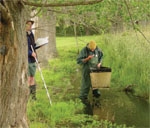Using invertebrates to assess stream quality – the trade-off between cost and accuracy

Landuse management practices, such as those associated with forestry or pastoral development, can put considerable pressure on freshwater ecosystems. Toxic substances, nutrients, and sediment can have adverse effects on stream insects, snails, and fish.
Biological assessment of stream health is preferred to chemical measurements (e.g., nutrient concentrations) because it provides more direct information on the ecological well-being of the stream. Furthermore, chemical measurements provide only a “snapshot” of conditions, whereas the stream biota is a product of all the “ups and downs” in environmental quality over time.
In New Zealand, most regulatory authorities biologically monitor streams by using macroinvertebrates. These are all the insects, crustaceans, molluscs, and other animals without backbones that are large enough to be seen without magnification. Common measurements include the number of different types of macroinvertebrates (the richness – a measure of biodiversity), and the proportions of macroinvertebrates that are considered most sensitive to pollution, such as mayflies, stoneflies, and most caddisflies.
However, a major contributor to the cost of biological monitoring is the time spent sorting samples. We wanted to understand how the amount of effort put into sorting influenced the reliability of the results, so we tested the effect of sample size on six commonly used measures of invertebrate community health in four Westland streams. Counts of 100 macroinvertebrates from samples collected at a number of sites along a stream gave an accurate assessment of the relative abundance of sensitive invertebrate groups and the degree to which a single taxon dominated the fauna, compared with counts of 200 or 300. (The use of 100-count assessments is not widespread in New Zealand, but has been common in North America.) However, 100 animal counts underestimated measures based on species presence or absence, such as biodiversity and stream health indices like the Macroinvertebrate Community Index.
An alternative approach to the fixed count sampling described above is to code abundance into classes such as rare, common and abundant. Another recent NIWA study compared these two techniques and concluded that coded abundance resulted in lower accuracy and loss of information compared with 100 animal counts.
So, biological assessments can be made quickly and accurately, and fixed counts provide more reliable results than coded abundance. However, you must be careful when comparing biodiversity assessments between different studies if different numbers of individuals have been counted.
Kevin Collier and Mike Scarsbrook [email protected]
